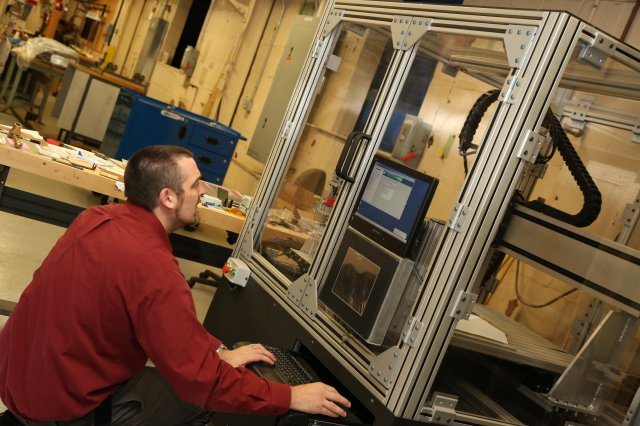As researchers at Picatinny Arsenal explore the potential of 3-dimensional printing, they envision the potential to embed a radio antenna on the side of a Soldier’s helmet, or print sensors directly onto a weapon or even an article of clothing.
Over the past few years, advancements in 3D printing have enabled scientists to print items ranging from body organs to candy.
At Picatinny, scientists and engineers are using additive manufacturing and 3D printing to print electronics, weapon components, and training models.
Additive manufacturing, which includes 3D printing, lets engineers create three-dimensional solid objects based on digital models, explained James Zunino, Materials Engineer and Printed Electronics, Energetic, Materials, & Sensors, or PEEMS, Co-Chair.
The printers work by using lasers or another heat source to meld gypsum, metal powders, plastic filaments or other materials “built” layer-by-layer to create tangible 3D objects.
At the forefront of Zunino’s 3D research is electronic printing — using an ink-jet printer to print electronics, such as munitions antennas, fuze elements and batteries.
Inks that can conduct electric current, such as silver, are printed in layers onto a film surface, creating conductors, semiconductors or resistors.
RADIO ANTENNA ON HELMET
This process allows engineers to potentially print sensors directly onto a weapon or an article of clothing. For instance, a radio antenna made of silver nanoparticles printed onto a flexible polyimide substrate could be embedded into a Soldier’s helmet, replacing the antenna that currently attaches to the headgear. Or, electronics could be printed on the side of artillery, freeing up space inside the round.
This ability allows printed electronics to use space more efficiently than conventionally made electronics.
Also, electronics created with 3D prints generate less waste.
“Instead of having to machine out the groves and put the sensor and the wires in the model, I can just use our printers to print electronics onto the model so they are already embedded,” Zunino said.
“With printed electronics versus conventional you’re not chemically etching away all the material, you’re printing them the way you want them. It’s more environmentally friendly, it’s more cost effective, and it’s more time efficient.”
The electronics could also be outfitted with reactive sensors, such as sensors that change properties in the presence of anthrax to detect and warn of the chemical’s presence.
Engineers at the Armament Research, Development and Engineering Center are frequently asked to create training pieces that can be used as aides for Soldiers.
“You can actually print a large version of a fuze mechanism to show the inner workings,” Zunino said. “You can quickly and cheaply try different designs and change parts. Rather than machining and wasting all that material, we can print them and even put electronics inside.
“You can input the 3D model into the printer, remove a 45-degree slice and print it out,” he continued. “With our color printer it will be printed in all the right colors and have the right markings, so you have a nice training aide.”
The engineers are also able to quickly fabricate items such as the wings of an unmanned aerial vehicle, known as a UAV.
PRINTING POTENTIAL PROVIDES GREATER FLEXIBILITY
Currently, there is no current way to create a UAV wing out of one sheet of metal because the holes for wiring are so intricate. The wings are now made with two pieces that are sealed together. But with 3D printing, engineers can place all the holes while the piece is being created.
Wires and printed electronics can even be embedded into the wings as they are created on the 3D printer.
“You can print UAV wings with the electronics, antennas and sensors in it so that when you’re done it’s all embedded in one encapsulated system,” Zunino said.
“It functions the same way, but you don’t have to worry about how to seal it, how to package it, how to glue it in. You just embed it inside using additive manufacturing techniques,” he said.
One reason 3D printing has so much potential is because it is extremely efficient. Items can be printed in a matter of minutes or hours depending on the complexity of the design. This makes it ideal for prototyping and low-rate production.
“I could try out a design on a 3D printer using a cheaper material,” Zunino said. “Once I know it works and my holes are good, I can go print it on a metals printer that uses stainless steel or titanium. So it’s a good cost savings, because you don’t want to buy metal in bulk. We can try different types of materials. 3D printing allows us to inexpensively test the same design in several different materials and see how they perform.”
3D TECHNOLOGY ADAPTED FOR COMBAT
In the near future, Picatinny scientists hope they will be able to print and assemble entire weapon systems in one manufacturing cube. For example, an entire claymore mine could be printed and assembled in one machine by using various tools and printing processes.
Zunino said it would also be beneficial for deployed Soldiers to have 3D scanners to scan a broken part, then send engineers the file from which engineers could make a new one.
“Ideally we would have the Soldiers have their own 3D printers in the field so that they could make their own part to hold them over until we send them the part. Normally, if they broke a bracket, it could take two or three weeks to replace it.”










